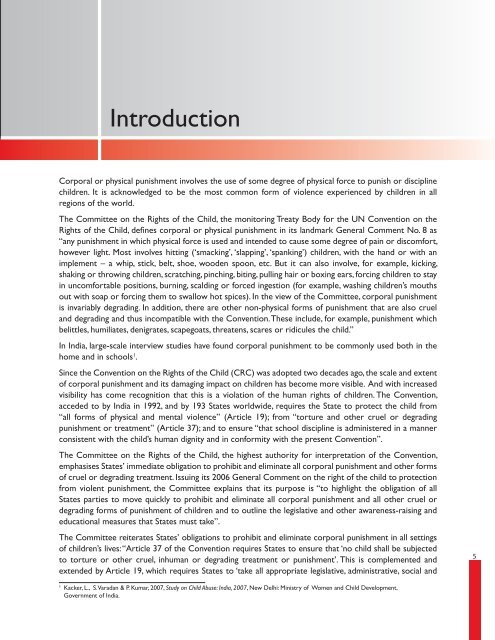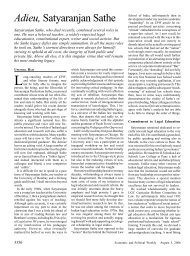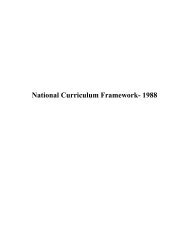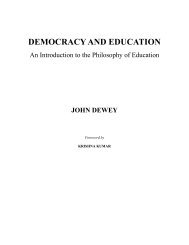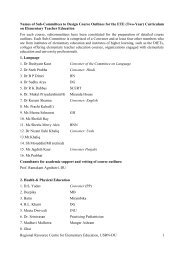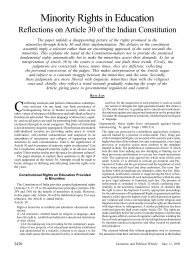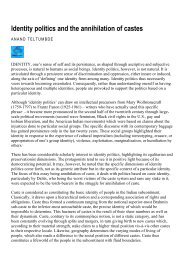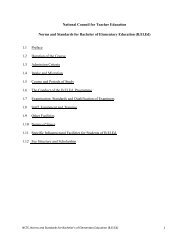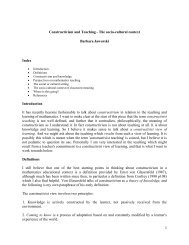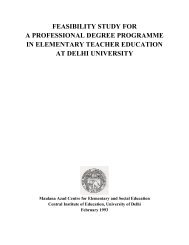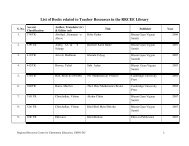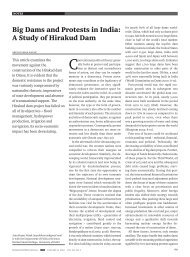Corporal Punishment - Eledu.net
Corporal Punishment - Eledu.net
Corporal Punishment - Eledu.net
Create successful ePaper yourself
Turn your PDF publications into a flip-book with our unique Google optimized e-Paper software.
IntroductionIntroduction<strong>Corporal</strong> or physical punishment involves the use of some degree of physical force to punish or disciplinechildren. It is acknowledged to be the most common form of violence experienced by children in allregions of the world.The Committee on the Rights of the Child, the monitoring Treaty Body for the UN Convention on theRights of the Child, defines corporal or physical punishment in its landmark General Comment No. 8 as“any punishment in which physical force is used and intended to cause some degree of pain or discomfort,however light. Most involves hitting (‘smacking’, ‘slapping’, ‘spanking’) children, with the hand or with animplement – a whip, stick, belt, shoe, wooden spoon, etc. But it can also involve, for example, kicking,shaking or throwing children, scratching, pinching, biting, pulling hair or boxing ears, forcing children to stayin uncomfortable positions, burning, scalding or forced ingestion (for example, washing children’s mouthsout with soap or forcing them to swallow hot spices). In the view of the Committee, corporal punishmentis invariably degrading. In addition, there are other non-physical forms of punishment that are also crueland degrading and thus incompatible with the Convention. These include, for example, punishment whichbelittles, humiliates, denigrates, scapegoats, threatens, scares or ridicules the child.”In India, large-scale interview studies have found corporal punishment to be commonly used both in thehome and in schools 1 .Since the Convention on the Rights of the Child (CRC) was adopted two decades ago, the scale and extentof corporal punishment and its damaging impact on children has become more visible. And with increasedvisibility has come recognition that this is a violation of the human rights of children. The Convention,acceded to by India in 1992, and by 193 States worldwide, requires the State to protect the child from“all forms of physical and mental violence” (Article 19); from “torture and other cruel or degradingpunishment or treatment” (Article 37); and to ensure “that school discipline is administered in a mannerconsistent with the child’s human dignity and in conformity with the present Convention”.The Committee on the Rights of the Child, the highest authority for interpretation of the Convention,emphasises States’ immediate obligation to prohibit and eliminate all corporal punishment and other formsof cruel or degrading treatment. Issuing its 2006 General Comment on the right of the child to protectionfrom violent punishment, the Committee explains that its purpose is “to highlight the obligation of allStates parties to move quickly to prohibit and eliminate all corporal punishment and all other cruel ordegrading forms of punishment of children and to outline the legislative and other awareness-raising andeducational measures that States must take”.The Committee reiterates States’ obligations to prohibit and eliminate corporal punishment in all settingsof children’s lives: “Article 37 of the Convention requires States to ensure that ‘no child shall be subjectedto torture or other cruel, inhuman or degrading treatment or punishment’. This is complemented andextended by Article 19, which requires States to ‘take all appropriate legislative, administrative, social and51Kacker, L., S. Varadan & P. Kumar, 2007, Study on Child Abuse: India, 2007, New Delhi: Ministry of Women and Child Development,Government of India.


